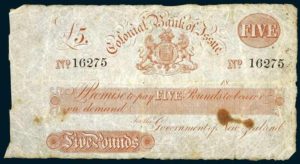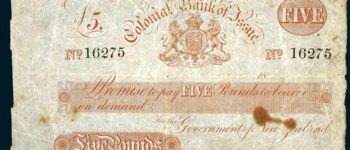1847: The Colonial Bank of Issue
July 2, 2020
By AHNZ
Back in 1847, Governor George Grey’s Government got its fingers into the business of banking. Grey created something called The Colonial Bank of Issue which was a colonial version of the latest State bank we have: Kiwi Bank (est 2001.)
Private New Zealanders, of course, were perfectly capable of supplying their own banking services and were suspicious of the Grey bank.¹ The State helped the public make its mind up by establishing their bank as a duopoly, outlawing all the competition. The only exception was the Union Bank of Australia whose paper money was already well established in New Zealand. (How the Union Bank showed its gratitude to Grey we may never know.) In 1850 this arrangement came to an end as the Grey League² made their bank and their money a total monopoly in New Zealand.
I can think of two major reasons that the The George Grey League would create this bank. The enabling Act, Paper Currency Act, makes it clear that all interest earned on New Zealander’s money held by the bank would go into Grey’s Government coffers…
Section 22- The interest to arise from the moneys so to be invested shall be applied in the first instance towards defraying the expenses incurred in conducting the business of the said Colonial Bank of Issue, and the surplus if any shall be paid to be Colonial Treasurer for the public uses of the Colony and the support of the Government thereof.”- NZLII
 Apart from being an indirect tax on the people, Grey’s gang would also be able to keep a close eye on the business doings of the colony. Grey had his finger on the pulse of the nation’s finances by appointing his old friend Dr Charles Knight to the role of Auditor General. Knight was a very loyal and long-serving member of the Grey League, serving in that post for 32 years! Grey’s Knight was also in charge of the Colonial Bank of Issue in its final years.
Apart from being an indirect tax on the people, Grey’s gang would also be able to keep a close eye on the business doings of the colony. Grey had his finger on the pulse of the nation’s finances by appointing his old friend Dr Charles Knight to the role of Auditor General. Knight was a very loyal and long-serving member of the Grey League, serving in that post for 32 years! Grey’s Knight was also in charge of the Colonial Bank of Issue in its final years.
The Great Colonial Bank of Issue Heist of 1864
After the Grey League dissolved (but not without a sequel) Colonel Gore Browne became New Zealand’s Governor and right away started handing over power to the Settlers themselves. One of the very first things the newly formed Responsible Government (1856) did was to wind up Grey’s Government’s funny money and open up competition for issuing notes once again. The State didn’t manage to get its clutches on banking to this supreme degree again until the Reserve Bank of New Zealand (1934.)
But the Colonial Bank of Issue was forgotten, not gone. There was unused stock, scores of books full up with 200 pages each and every page was one of these antique £5 notes! Like the Arc of the Covenant at the end of Raiders of the Lost Arc, these money books sat festering down in the Government memory hole and probably behind a disused lavatory with a sign on the door saying ‘Beware of the Leopard³.”
“But the plans were on display…”
“On display? I eventually had to go down to the cellar to find them.”
“That’s the display department.”
“With a flashlight.”
“Ah, well, the lights had probably gone.”
“So had the stairs.”
“But look, you found the notice, didn’t you?”
“Yes,” said Arthur, “yes I did. It was on display in the bottom of a locked filing cabinet stuck in a disused lavatory with a sign on the door saying ‘Beware of the Leopard.” – Hitchiker’s Guide to the Galaxy“These books, the notes of, which were of course unsigned, were packed in boxes which have been, it seems lying about in some of the Government lumber rooms from the day of the winding up of the Colonial Bank of Issue to the present time.”- Southland Times, 29 October 1864; Papers Past
Dr Knight or other members of the Grey League probably left this fortune quite secure but over time it became nothing but another pile of forgotten boxes. Perhaps they were only stirred up at last because the capital was being shifted from Auckland to Wellington. (The Government is always careless and should never be trusted with money or personal information or historical archives.) By the end of 1865 the money was still on the loose!
Trying to chase down the missing fortune, The State played a funny game of Double Think. On the one hand, they assured everyone, the money was obsolete and antique and of no use. On the other, they said they were “disused and worthless.” By the end of 1865 some £12,250 of the missing notes had been discovered in a residential house in Brisbane⁴.
Leading up to this bust, the State bitterly said, “We cannot avoid saying that any banker who accepts such paper at genuine notes deserves to be victimised,” and, “they are unique, and may be detected by a child.”⁵ Pretty passive aggressive language coming from a Government stung by embarrassment!
Of course, the great irony is that The State was so offended to be robbed when what was taken from them were nothing more than some old swindle sheets that The State had used to rob New Zealanders for a decade.
—
1 Ref. Banking and finance; Te Ara
2 Ruled New Zealand, 18 November 1845 – 3 January 1854 and again December 1861 – 5 February 1868
3 Probably in Princess Street, Auckland
4 Ref. Colonist (1865); Papers Past
5 Ref. Daily Southern Cross (1865); Papers Past
Image ref. A £5 note from the Colonial Bank of Issue; Noble Numismatics Pty Ltd
 Like Comment Share
Like Comment Share







